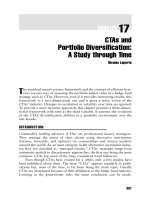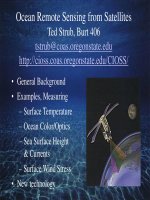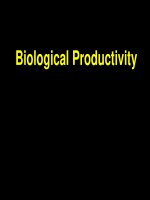TOXICOLOGICAL CHEMISTRY AND BIOCHEMISTRY - CHAPTER 17 pps
Bạn đang xem bản rút gọn của tài liệu. Xem và tải ngay bản đầy đủ của tài liệu tại đây (463.35 KB, 16 trang )
C
HAPTER
17
Organosulfur Compounds
17.1 INTRODUCTION
Sulfur is directly below oxygen in the periodic table. The sulfur atom has six valence electrons,
as shown in Figure 17.1, and its electron configuration is {Ne}3
s
2
3
p
4
. Because of their very similar
valence shell electron configurations, oxygen and sulfur behave somewhat alike chemically. How-
ever, unlike oxygen, the sulfur atom has three underlying 3
d
orbitals, and its valence shell can be
expanded to more than eight electrons. This makes sulfur’s chemical behavior more diverse than
that of oxygen. For example, sulfur has several common oxidation states, including –2, +4, and
+6, whereas most chemically combined oxygen is in the –2 oxidation state.
17.1.1 Classes of Organosulfur Compounds
The hydride of sulfur is H
2
S (Figure 17.1), a highly toxic gas discussed in Section 11.9.
Substitution of alkyl or aryl hydrocarbon groups such as phenyl and methyl (Figure 17.1) for H on
hydrogen sulfide leads to a number of different organosulfur compounds. These include thiols
(R–SH) and thioethers (R–S–R). Because of the availability of 3
d
orbitals, sulfur that is bonded to
hydrocarbon moieties can also be bonded to oxygen, adding to the variety of organosulfur com-
pounds that can exist.
Despite the high toxicity of H
2
S, not all organosulfur compounds are particularly toxic. Many
of the compounds have strong, offensive odors that warn of their presence, which reduces their
hazard.
17.1.2 Reactions of Organic Sulfur
Organic sulfur undergoes a number of toxicological chemical reactions. These include the
following:
• Oxidation of sulfur
• Reduction of sulfur
• Removal of sulfur from a molecule
• Addition of sulfur-containing groups
Examples of these kinds of reactions, some of which are very important in xenobiotic metab-
olism, are given below.
Oxidation of sulfur is called
S-oxidation
. Thiols can be oxidized to form disulfides:
2R–SH + {O}
→
R–S S–R + H
2
O (17.1.1)
L1618Ch17Frame Page 347 Tuesday, August 13, 2002 5:40 PM
Copyright © 2003 by CRC Press LLC
The same kind of reaction occurs with aminothiols, such as in the oxidation of cysteamine,
H
2
NCH
2
CHSH, to cystamine, H
2
NCH
2
CH
2
S SCH
2
CH
2
NH
2
. S-oxidation may also involve sulfur
in organosulfide compounds:
(17.1.2)
and sulfur on thioamides:
(17.1.3)
An example of sulfur reduction is
disulfide reduction
, as shown by the following reaction:
(17.1.4)
This reaction converts disulfiram, a therapeutic agent for the treatment of alcohol abuse, discussed
in Section 17.3, to dithiocarb (diethylthiocarbamate), a substance that strongly binds metals and is
used for the treatment of nickel carbonyl poisoning.
Desulfuration is the term given to removal of sulfur from a molecule. One of the most common
desulfuration reactions occurs with sulfur bonded to phosphorus. A common desulfuration reaction
is the enzyme-mediated conversion of parathion to paraoxon (see discussion of organophosphate
insecticides in Section 18.7):
(17.1.5)
Figure
17.1
Sulfur atom, compounds, and substituent groups.
C
H
H
H
SCS
:
.
.
S
::
H
H
S
Lewis symbol
of sulfur atom
Lewis structure of
hydrogen sulfide
Carbon
disulfide
Phenyl group Methyl group
Sulfoxidation
{O}
SRR'
S
O
RR'
RC
S
N
H
H
RC
S
N
O
H
H
S-oxidation
Enzymatic
reduction
2
Disulfiram Dithiocarb
S SCCNN
C
2
H
5
C
2
H
5
H
5
C
2
H
5
C
2
SS
HS C N
C
2
H
5
C
2
H
5
S
{O}, enzymatic
oxidation
Parathion Paraoxon
OP
O
C
2
H
5
NO
2
H
5
C
2
O
O
O
C
2
H
5
S
H
5
C
2
PNO
2
OO
L1618Ch17Frame Page 348 Tuesday, August 13, 2002 5:40 PM
Copyright © 2003 by CRC Press LLC
The most significant instance of addition of a sulfur-containing group is the phase II conjugation
to sulfate of a xenobiotic compound or its phase I metabolite (see Section 7.4.3) by the action of
adenosine 3'-phosphate-5'-phosphosulfate, a sulfotransferase enzyme that acts as a sulfating agent:
(17.1.6)
17.2 THIOLS, SULFIDES, AND DISULFIDES
Substitution of alkyl and aryl groups for H on H
2
S yields
thiols
and
sulfides
(thioethers).
Structural formulas of examples of these compounds are shown in Figure 17.2.
17.2.1 Thiols
Thiols are also known as mercaptans. The lighter alkyl thiols, such as methanethiol, are fairly
common air pollutants with odors that may be described as ultragarlic. Inhalation of even very low
concentrations of the alkyl thiols in air can be very nauseating and result in headaches. Exposure
Figure
17.2
Common low-molecular-mass thiols and sulfides. All are liquids at room temperature, except for
methanethiol, which boils at 5.9°C.
HC SH
H
H
H
H
H
HCCCSH
H
H
H
HCC SH
H
H
H
H
H
H
H
CCCSH
H
H
C
HH
H
H
H
CCCSH
H
H
H
H
CSH
H
H
SH
SH SCC
H
H
H
H
H
H
S
S
CCC
H
H
H
H
H
CH
H
H
H
S
H
Methanethiol Ethanethiol 1-Propanethiol
2-Propene-1-thiol 1-Butanethiol 2-Butanethiol
1-Pentanethiol Alpha-toluenethiol Cyclohexanethiol
HC
H
H
CC
H
H
H
H
SH
3
HC
H
H
CC
H
H
H
H
SH
8
1-Decanethiol Benzenethiol Dimethyl sulfide
Thiophene (an unsaturated
cyclic sulfide)
Thiophane
HC
H
H
SC
H
H
Methylbenzyl sulfide
OH
O
-
H
+
S
O
O
+
Phenol Phase II sulfate conjugate
SOH
O
O
(Sulfating agent)
L1618Ch17Frame Page 349 Tuesday, August 13, 2002 5:40 PM
Copyright © 2003 by CRC Press LLC
to higher levels can cause increased pulse rate, cold hands and feet, and cyanosis. With extreme
cases, unconsciousness, coma, and death may occur. The biochemical action of alkyl thiols likely
is similar to that of H
2
S, and they are precursors to cytochrome oxidase poisons.
Volatile methanethiol from biogenic sources is released to the atmosphere in coastal and ocean
upwelling areas.
1
Methanethiol and volatile liquid ethanethiol (bp, 35°C) are intermediates in
pesticide synthesis and odorants placed in lines and tanks containing natural gas, propane, and
butane to warn of leaks. Information about their toxicities to humans is lacking, although these
compounds and 1-propanethiol should be considered dangerously toxic, especially by inhalation.
Also known as amyl mercaptan, 1-pentanethiol (bp, 124°C) is an allergen and weak sensitizer that
causes contact dermatitis.
Anaerobic bacteria in the colon produce significant quantities of methanethiol along with
hydrogen sulfide. Rodent studies indicate that these substances are detoxified to thiosulfate by the
action of a specialized detoxification system that operates in the mucous layer of the colon lining.
2
The failure of this system may contribute to some diseases of the colon, such as ulcerative colitis.
A typical alkenyl mercaptan is 2-propene-1-thiol, also known as allyl mercaptan. It is a volatile
liquid (bp, 68°C) with a strong garlic odor. It has a high toxicity and is strongly irritating to mucous
membranes when inhaled or ingested.
Alpha-toluenethiol, also called benzyl mercaptan (bp, 195°C) is very toxic orally. It is an
experimental carcinogen.
The simplest of the aryl thiols is benzenethiol, phenyl mercaptan (bp, 168°C). It has a severely
repulsive odor. Inhalation causes headache and dizziness, and skin exposure results in severe contact
dermatitis.
17.2.2 Thiols as Antidotes for Heavy Metal Poisoning
Toxic heavy metals, such as cadmium, lead, and mercury, are sulfur seekers that bind strongly
with thiol groups, which is one of the ways in which they interact adversely with biomolecules,
including some enzymes. Advantage has been taken of this tendency to use thiols in chelation
therapy in heavy metal poisoning. Among the thiols tested for this purpose are
meso
-2,3-dimer-
captosuccinic acid, diethyldimercapto succinate,
α
-mercapto-
β
-(2-furyl), and
α
-mercapto-
β
-(2-
thienyl) acrylic acid.
3
The structural formulas for the first two are
17.2.3 Sulfides and Disulfides
Dimethylsulfide is an alkyl sulfide or thioether. It is a volatile liquid (bp, 38°C) that is moderately
toxic by ingestion. Thiophene is the most common cyclic sulfide. It is a heat-stable liquid (bp,
84°C) with a solvent action much like that of benzene. It is used in the manufacture of pharma-
ceuticals and dyes, as well as resins that also contain phenol or formaldehyde. Its saturated analog
is tetrahydrothiophene, or thiophane.
Ruminant animals produce dimethylsulfide, a fraction of which is exhaled.
4
Therefore, cows’
breath is a source of this compound in terrestrial atmospheres. Dimethylsulfide is produced in
enormous quantities by marine organisms. This volatile compound is the largest source of biogenic
sulfur in the atmosphere and is responsible for some of the odor emanating from coastal mud flats.
C
C
SH
SH
O
OH
O
HO
meso -2,3-Dimercaptosuccinic acid
C
O
C
H
SH
C
H
SH
CO
O
O
H
H
C
H
H
CH CCH
HH
HH
Diethyldimercapto succinate
L1618Ch17Frame Page 350 Tuesday, August 13, 2002 5:40 PM
Copyright © 2003 by CRC Press LLC
It, along with methylbenzyl sulfide and one or two other sulfides, is responsible for the nauseating
stench of
Halichondria panicea
, a marine sponge.
The organic disulfides contain the –SS– functional group, as shown in the following two
examples:
These compounds may act as allergens that produce dermatitis in contact with skin. Not much
information is available regarding their toxicities to humans, although animal studies suggest several
toxic effects, including hemolytic anemia.
17.2.4 Organosulfur Compounds in Skunk Spray
Skunks are small animals that wage powerful defensive warfare in the form of spray that has
a sickening offensive odor. The compounds that are responsible for skunk spray odor are organo-
sulfur compounds. Although seven or more such compounds have been isolated from the spray of
the striped skunk,
Mephitis mephitis
, it is now believed that there are only three major ones:
trans
-
2-butene-1-thiol,
trans
-2-butenyl-1-thioacetate, and 3-methyl-1-butanethiol
5
:
17.2.5 Carbon Disulfide and Carbon Oxysulfide
Carbon disulfide
(CS
2
) is one of the most significant sulfur compounds because of its wide-
spread use and toxicity. This compound has two sulfur atoms, each separately bonded to a carbon
atom. This compound is a volatile, colorless liquid (mp, –111°C; bp, 46°C). Unlike most organo-
sulfur compounds, it is virtually free of odor. Although its uses are declining, it has numerous
applications in chemical synthesis, as a solvent to break down cellulose in viscose rayon manufac-
ture, and in the manufacture of cellophane. It has also been used as an insecticide and fumigant.
Acute doses of carbon disulfide inhaled at 100 to l000 ppm irritate mucous membranes and
affect the central nervous system, usually causing excitation as a first noticeable effect, followed
by restlessness, depression, and stupor. Carbon disulfide intoxication causes reduced conduction
velocity in the peripheral nerves, which can be detected by psychomotor tests that exhibit impaired
performance.
6
It is a much stronger anesthetic than chloroform (Section 16.2), causing unconscious-
ness and even death in cases of high exposure. Symptoms experienced during recovery from severe
acute carbon disulfide poisoning resemble those that occur following intoxication from ingestion
of ethanol in alcoholic beverages.
HCCCCSSCCCCH
HHHH
HHHH
HHHH
HHHH
SS
n-Butyldisulfide Diphenyldisulfide
Trans -2-butene-1-thiol
C
H
H
H
H
H
CC
HS
H
H
C
C
H
H
H
H
H
CC
S
H
H
CC
O
C
H
H
H
Trans -2-butenyl-1-
thioacetate
3-Methyl-1-butane-
thiol
HS C
H
H
C
H
H
CC
HH
H
H
CH
3
L1618Ch17Frame Page 351 Tuesday, August 13, 2002 5:40 PM
Copyright © 2003 by CRC Press LLC
Chronic carbon disulfide poisoning by absorption through the skin or respiratory tract involves the
central and peripheral nervous systems and may cause anemia. Symptoms include indistinct vision,
neuritis, and a bizarre sensation of “crawling” on the skin. Psychopathological symptoms may be varied
and severe, including excitation, depression, irritability, and general loss of mental capabilities to the
point of insanity. Parkinsonian paralysis may result from chronic carbon disulfide poisoning.
Carbon disulfide is metabolized by conjugating with the amino acid cysteine to form adducts
that rearrange to produce 2-thiothiazolidine-4-carboxylic acid (TTCA):
(17.2.1)
TTCA is commonly determined by chemical analysis of urine as a biomarker of exposure to carbon
disulfide. Another metabolite of carbon disulfide that appears at levels of about 30% those of TTCA
in workers exposed to carbon disulfide is 2-thioxothiazolidin-4-ylcarbonylglycine
7
:
Replacement of one of the S atoms on carbon disulfide with an O atom yields
carbon oxysulfide
(COS), a volatile liquid boiling at 50°C. It can decompose to liberate toxic hydrogen sulfide. Carbon
oxysulfide vapor is a toxic irritant. At high concentrations this compound has a strong narcotic effect.
17.3 ORGANOSULFUR COMPOUNDS CONTAINING NITROGEN OR PHOSPHORUS
Several important classes of organosulfur compounds contain nitrogen or phosphorus. These
compounds are discussed in this section.
17.3.1 Thiourea Compounds
Thiourea
is the sulfur analog of urea. Substitution of hydrocarbon moieties on the N atoms
yields various organic derivatives of thiourea, as illustrated in Figure 17.3. Thiourea has been used
as a rodenticide. It has a moderate to high toxicity to humans, affecting bone marrow and causing
anemia. It has been shown to cause liver and thyroid cancers in experimental animals.
Phenylthiourea
is likewise a rodenticide. Its toxicity is highly selective to rodents relative to
humans, although it probably is very toxic to some other animals. The compound is metabolized
extensively, and some of the sulfur is excreted as sulfate in urine.
Commonly called ANTU,
1-naphthylthiourea
is a virtually tasteless rodenticide that has a
very high rodent:human toxicity ratio. The lethal dose to monkeys is about 4000 mg/kg. One
SCS
HS C
H
H
CCOH
O
H
N
HH
Cysteine
SNH
CO
2
H
S
TTCA
2-thioxothiazolidin-4-ylcarbonylglycine
SNH
S
CN
O
H
C
H
H
COH
O
L1618Ch17Frame Page 352 Tuesday, August 13, 2002 5:40 PM
Copyright © 2003 by CRC Press LLC
suicidal adult male human ingested about 80 g of 30% ANTU rat poison, along with a considerable
amount of alcohol. He vomited soon after ingestion and survived without significant ill effects.
8
Dogs, however, are quite susceptible to ANTU poisoning.
17.3.2 Thiocyanates
Organic
thiocyanates
are derivatives of thiocyanic acid (HSCN), in which the H is replaced
by hydrocarbon moieties, such as the methyl group. Dating from the 1930s and regarded as the
first synthetic organic insecticides, these compounds kill insects on contact. Because of their
volatilities, the lower-molecular-mass methyl, ethyl, and isopropyl thiocyanates are effective fumi-
gants for insect control. Insecticidal lauryl thiocyanate (below) is not volatile and is used in sprays
in petroleum-based solvents and in dusting powders.
The toxicities of the thiocyanates vary widely by compound and route of administration. Some
metabolic processes liberate HCN from thiocyanates. As discussed in Section 11.2.1, HCN is highly
toxic, so its generation in the body can result in death. Therefore, methyl, ethyl, and isopropyl
thiocyanates should be regarded as rapid-acting, potent poisons.
The
isothiocyanate
group is illustrated in the structure below:
Other compounds in this class include ethyl, allyl, and phenyl isothiocyanates. Methylisothiocyan-
ate, also known as methyl mustard oil, and its ethyl analog have been developed as military poisons.
Both are powerful irritants to eyes, skin, and the respiratory tract. When decomposed by heat, these
compounds emit sulfur oxides and hydrogen cyanide. Methylisothiocyanate occurs in the environ-
ment from some kinds of vegetables, as a breakdown product of some carbamate insecticides, and
from deliberate addition to soil for fumigation.
9
It is a degradation product of the fungicide Vapam:
Figure
17.3
Structural formulas of urea, thiourea, and organic derivatives of thiourea. *At least one R group
is an alkyl, alkenyl, or aryl substituent.
Urea Thiourea Organic derivatives
of thiourea*
1-Naphthylthiourea (ANTU)Phenylthiourea
NCN
H
H
H
H
O
H
NCN
H
H
H
S
R
NCN
R
R
R
S
NCN
H
H
H
S
NCN
H
H
H
S
H
H
CCCCCCCCCCCCSC
HHHHHHHHHHHH
HHHHHHHHHHH
N
Lauryl thiocyanate
CN
H
H
H
CS
Methylisothiocyanate
L1618Ch17Frame Page 353 Tuesday, August 13, 2002 5:40 PM
Copyright © 2003 by CRC Press LLC
17.3.3 Disulfiram
Disulfiram
, is a sulfur- and nitrogen-containing compound with several industrial uses, includ-
ing applications as a rubber accelerator and vulcanizer, fungicide, and seed disinfectant. It is most
commonly known as antabuse, a therapeutic agent for the treatment of alcohol abuse that causes
nausea, vomiting, and other adverse effects when ethanol is ingested. Disulfiram is an inhibitor of
aldehyde dehydrogenase so that it allows for buildup of the acetaldehyde metabolite of ethanol,
causing unpleasant effects that are a deterrent to the ingestion of alcohol. Because of the buildup
of acetaldehyde, disulfiram should be given with extreme caution, especially to individuals suffering
from liver cirrhosis.
17.3.4 Cyclic Sulfur and Nitrogen Organic Compounds
The structural formulas of several cyclic compounds containing both nitrogen and sulfur are
shown in Figure 17.4. Basic to the structures of these compounds is the simple ring structure of
thiazole
. It is a colorless liquid (bp, 117°C). One of its major uses has been for the manufacture
of sulfathiazole, one of the oldest of the sulfonamide class of antibacterial drugs. The use of
sulfathiazole is now confined to the practice of veterinary medicine because of its serious side
effects.
Several derivatives of thiazole have commercial uses. One of these is
2-aminothiazole
, which
has shown a high toxicity to experimental animals.
Benzothiazole
is another related compound
used in organic synthesis. Thiazoles are used as rubber vulcanization accelerators. Benzothiazole,
Figure
17.4
Cyclic compounds containing nitrogen and sulfur.
HS C
S
NCH
H
H
H
Vapam
C
H
H
C
H
H
C
H
H
C
H
H
HC
H
H
C
H
H
HC
H
H
C
H
H
SS
NCSSCN
Disulfiram (antabuse)
N
S
N
SSH
N
S
N
N
N
S
H
N
SNH
2
Thiazole Benzothiazole 2-Aminothiazole
2-Mercaptobenzothiazole
Thiabendazole
N
S
SCSCN
H
H
2-(Thiocyanomethylthio)-
benzothiazole (fungicide)
N
S SCH
3
2-(Methylthio)benzo-
thiazole
L1618Ch17Frame Page 354 Tuesday, August 13, 2002 5:40 PM
Copyright © 2003 by CRC Press LLC
2-mercaptobenzothiazole, and 2-(methylthio)benzothiazole are breakdown products of fungicidal
2-(thiocyanomethylthio)benzothiazole and are common constituents of tannery wastewaters. The
human toxicity of 2-(thiocyanomethylthio)benzothiazole is not known, although it has a high
toxicity to mice.
Thiabendazole
, 2-(4'-thiazoyl)benzimidazole, is a systemic fungicide that can be
carried through a plant and onto plant leaves. Rats and dogs tolerate a relatively high dose of this
chemical, although it tends to make the latter vomit. Acting as an adjuvant (a substance added to
a drug or insecticide to give it a desired form and enhance its action and effectiveness), 2-
mercaptobenzothiazole is mixed with dithiocarbamate fungicides (see below) to increase their
potency. It is an allergen that causes type IV (cell-mediated) hypersensitivity. This condition is
manifested by contact dermatitis and a delayed hypersensitive reaction that follows a latent period
after exposure. This cell-mediated process results from the sensitization of T lymphocytes.
17.3.5 Dithiocarbamates
Dithiocarbamate fungicides consist of metal salts of
dimethylthiocarbamate
and
ethylenebis-
dithiocarbamate
anions, as shown in Figure 17.5. These fungicides are named in accordance with
the metal ion present. For example, the manganese salt of dimethyldithiocarbamate is called maneb,
and the zinc and sodium salts are zineb and nabam, respectively. The iron salt of ethylenebisdithio-
carbamate is called ferbam, and the zinc salt of this ion is called ziram. These salts are chelates
(Section 2.3) in which two S atoms from the ethylenebisdithiocarbamate anion are bonded to the
same metal ion in a ring structure.
The dithiocarbamate fungicides have been popular for agricultural use because of their effec-
tiveness and relatively low toxicities to animals. However, there is concern over their environmental
breakdown products, particularly ethylenethiourea (2-imidazolidine thione; see Figure 17.5), which
is toxic to the thyroid and has been shown to be mutagenic, carcinogenic, and teratogenic in
experimental animals.
17.3.6 Phosphine Sulfides
A number of toxicologically important organic compounds have sulfur bound to phosphorus.
The simplest of these are the phosphine sulfides, containing only carbon, hydrogen, phosphorus,
and sulfur, as illustrated by the example below:
Phosphine sulfides tend to be toxic. When burned, they give off dangerous phosphorus oxide and
sulfur oxide fumes.
Figure
17.5
Dithiocarbamate anions and ethylenethiourea.
-
SCN
CH
3
CH
3
S
-
SCN
SH
CCNCS
-
SHH
HH
N
CC
N
C
S
HH
HH
HH
Dimethyldithiocar-
bamate anion
Ethylenebisdithio-
carbamate anion
Ethylenethiourea
PC
4
H
9
C
4
H
9
S
C
4
H
9
Tributylphosphine sulfide
L1618Ch17Frame Page 355 Tuesday, August 13, 2002 5:40 PM
Copyright © 2003 by CRC Press LLC
17.3.7 Phosphorothionate and Phosphorodithioate Esters
The most toxicologically significant organic compounds that contain both phosphorus and sulfur
are the thiophosphate esters, which are used as insecticidal acetylcholinesterase inhibitors. The
general formulas of insecticidal
phosphorothionate
and
phosphorodithioate
esters are shown in
Figure 17.6, where R is usually a methyl (–CH
3
) or ethyl (–C
2
H
5
) group, and Ar is a moiety of
more complex structure, frequently aromatic. Phosphorothionate and phosphorodithioate esters
contain the P=S (thiono) group, which increases their insect:mammal toxicity ratios and decreases
their tendency to undergo nonenzymatic hydrolysis, compared to their analogous compounds that
contain the P=O functional group. The metabolic oxidative desulfuration conversion of P=S to P=O
in organisms (see Section 17.1) converts the phosphorothionate and phosphorodithioate esters to
species that have insecticidal activity.
17.4 SULFOXIDES AND SULFONES
Numerous important organic compounds contain oxygen bonded to sulfur. Among these com-
pounds are the sulfoxides and sulfones, shown by the examples in Figure 17.7.
Figure 17.6 General formulas and specific examples of phosphorothionate and phosphorodithioate organo-
phosphate insecticides.
Figure 17.7 Sulfoxides and sulfones.
OORP
S
O
R
Ar
C
2
H
5
C
2
H
5
O
O
OPNO
2
Cl
S
O
S
PONO
2
C
2
H
5
S
C
2
H
5
O
R
S
PRO ArS
C
2
H
5
CC
2
H
5
CH
3
CCH
HOP
H
SC
O
S
O
CH
3
O
O
C
2
H
5
OSP CCC
2
H
5
S
O
C
2
H
5
HH
HH
General formula of
phosphorothionate
insecticides
Parathion
General formula of
phosphorodithioate
insecticides
Chlorothion
Malathion Disulfoton
HC SCH
OHH
HH
S
OO
HC SCH
O
O
H
H
H
H
Dimethylsulfoxide Dimethylsulfone Sulfolane
(DMSO)
L1618Ch17Frame Page 356 Tuesday, August 13, 2002 5:40 PM
Copyright © 2003 by CRC Press LLC
Dimethylsulfoxide (DMSO) is a liquid with numerous uses and some very interesting proper-
ties. It occurs in the atmosphere over and near oceans as an oxidation product of dimethylsulfide
produced by biological marine sources. Mixed with water, DMSO produces a good antifreeze
solution. It is also employed to remove paint and varnish and as a hydraulic fluid. It has some
potential pharmaceutical applications, for example, as an antiinflammatory and bacteriostatic agent.
It has the ability to carry solutes into the skin’s stratum corneum (see Figure 6.4), from which they
are slowly released into the blood and lymph system. This phenomenon has some pharmaceutical
potential, as well as some obvious hazards. Dimethylsulfoxide has a remarkably low acute toxicity,
with an LD
50
of 10 to 20 g/kg in several kinds of experimental animals. DMSO applied to the skin
rapidly spreads throughout the body, and the subject experiences a taste in the mouth resembling
that of garlic and quickly develops a garlic odor in the breath. The main acute toxic effects of
DMSO are inhibition of acetylcholinesterase and breakdown of red blood cells (hemolysis). Some
DMSO is excreted directly in the urine, and it also undergoes partial metabolism to dimethylsulfide
and dimethylsulfone (Figures 17.2 and 17.7, respectively).
Although dimethylsulfone has some commercial uses, sulfolane (Figure 17.7) is the most
widely used sulfone. It is a polar aprotic (no ionizable H) solvent with a relatively high dielectric
constant, and it dissolves both organic and inorganic solutes. When ionic compounds are dissolved
in sulfolane, the cations are solvated (bound by the solvent) rather strongly. However, the anions
are left in a relatively unsolvated form, which tends to increase their reactivities substantially. The
major commercial use of sulfolane is in an operation called BTX processing, in which it selectively
extracts benzene, toluene, and xylene from aliphatic hydrocarbons. It is also the solvent in the
Sulfinol process by which thiols (Section 17.2) and acidic compounds are removed from natural
gas. Sulfolane is used as a solvent for polymerization reactions and as a polymer plasticizer.
Exposure to sulfolane can cause eye and skin irritation, although its overall toxicity is relatively low.
17.5 SULFONIC ACIDS, SALTS, AND ESTERS
Sulfonic acids contain the –SO
3
H group attached to a hydrocarbon moiety. For many applica-
tions these acids are converted to salts, such as sodium 1-(p-sulfophenyl)decane, a biodegradable
detergent surfactant. Its structural formula and those of two sulfonic acids are shown in Figure 17.8.
In general, the sulfonic acids are water soluble and are strong acids because of virtually complete
loss of ionizable H
+
in aqueous solution. They have some important commercial applications, such
as in the hydrolysis of fats and oils (see Section 3.5) to fatty acids and glycerol. Benzenesulfonic
acid is fused with NaOH in the preparation of phenol. Dyes and some pharmaceutical compounds
are manufactured from p-toluenesulfonic acid. Methanesulfonic acid has been developed as an
esterification catalyst in place of sulfuric acid for the synthesis of resins in paints and coatings.
Figure 17.8 Sulfonic acids and a sulfonate salt.
Na
+
HCCCCSOH
HHHH
HHHH
O
O
SOH
O
O
HCCCCCCCCCC SO
-
HHHHHHHHHH
HHHHHHHHHH
O
O
Butanesulfonic acid Benzenesulfonic acid
Sodium 1-(p-sulfophenyl)decane
L1618Ch17Frame Page 357 Tuesday, August 13, 2002 5:40 PM
Copyright © 2003 by CRC Press LLC
One of the major advantages of methanesulfonic acid over sulfuric acid is that it is not an oxidizing
species.
Benzenesulfonic acid and p-toluenesulfonic acid are strong irritants to skin, eyes, and mucous
membranes. Solutions of sulfonic acids are strongly acidic, and precautions appropriate to the
handling of strong acids should be taken with them.
The methyl ester of methylsulfonic acid is methylmethane sulfonate. Its structural formula is
Toxicologically, it has been classified as a primary or direct-acting carcinogen that does not require
metabolic conversion to act as a carcinogen.
10
Both it and ethyl methane sulfonate are strong
biological alkylating agents, although they are regarded as only weak carcinogens.
17.6 ORGANIC ESTERS OF SULFURIC ACID
As shown in Figure 17.9, esters of sulfuric acid exist in which either one or both of the ionizable
H atoms are replaced by hydrocarbon substituents, such as the methyl group. Replacement of one
H yields an acid ester, and replacement of both yields an ester. Metabolically, acid ester sulfates
are synthesized in phase II reactions to produce water-soluble products of xenobiotic compounds
(such as phenol) that are readily eliminated from the body (see Section 7.4).
Sulfuric acid esters have several industrial uses, especially as alkylating agents, which act to
attach alkyl groups (such as methyl) to organic molecules. Among the products made with sulfuric
acid ester reactants are agricultural chemicals, dyes, and drugs.
Methylsulfuric acid is an oily water-soluble liquid. It is a strong irritant to skin, eyes, and
mucous tissue. Ethylsulfuric acid is likewise an oily liquid and a strong tissue irritant. Sodium
ethylsulfate is a hygroscopic white crystalline solid.
Dimethylsulfate is a liquid (bp, 188°C; fp, –32°C). It is colorless, odorless, and highly toxic.
It has been classified as a primary carcinogen.
10
When skin or mucous membranes are exposed to
dimethylsulfate, there is an initial latent period during which few symptoms are observed. After
this period, conjunctivitis and inflammation of nasal tissue and respiratory tract mucous membranes
develop. Heavier exposures damage the liver and kidney and cause pulmonary edema and cloudiness
of the cornea. Death can follow in 3 or 4 days. The related compound, diethylsulfate, is an oily
liquid. It reacts with water to yield sulfuric acid. Like dimethylsulfate, it is a strong irritant to tissue
and has proven to be carcinogenic in experimental animals.
Figure 17.9 Sulfuric acid and organosulfate esters.
OHC S
OH
H
H
O
O
HCCO S
OH
HH
HH
O
O
HCCO SO
-
Na
+
HH
HH
O
O
OHC SOCH
H
H
H
H
O
O
Sulfuric acid Methylsulfuric acid Ethylsulfuric acid
Sodium ethylsulfate Dimethylsulfate
S
OH
O
O
HO
HC
H
H
SOCH
H
H
O
O
Methylmethane sulfonate
L1618Ch17Frame Page 358 Tuesday, August 13, 2002 5:40 PM
Copyright © 2003 by CRC Press LLC
17.7 MISCELLANEOUS ORGANOSULFUR COMPOUNDS
A number of sulfur compounds containing other elements, such as halides, are used for various
purposes. Some examples of such compounds are shown in Figure 17.10 and discussed briefly here.
17.7.1 Sulfur Mustards
The first three compounds shown in Figure 17.10 are sulfur mustards, which are highly toxic
military poisons, or poison gases. These are mustard oil (bis(2-chloroethyl)sulfide), sesquimustard
(1,2-bis(2-chloroethylthio)ethane), and O-mustard (bis(2-chloroethylthioethyl)ether). The toxic
properties of mustard oil are typical of those of the sulfur mustards. As a military blistering gas
poison, the vapors of this compound are very penetrating, so that it damages and destroys tissue
at some depth from the point of contact. Affected tissue becomes severely inflamed, and the resulting
lesions often become infected. Death can result from pulmonary lesions. Part of the hazard of
mustard oil stems from the speed with which it penetrates tissue, so that efforts to remove it from
the exposed area are ineffective after about 30 min. The compound is an experimental mutagen
and primary carcinogen.
17.7.2 Sulfur in Pesticides
In Section 17.3, rodenticidal thioureas, insecticidal thiocyanates, and fungicidal dithiocarbam-
ates were discussed. Sulfur is a common constituent of other classes of insecticides. These prom-
inently include the organophosphate insecticides discussed in Chapter 18. Mobam (Figure 17.10)
is a contact insecticide of the carbamate type, closely related in structure and function to the well-
known carbamate insecticide carbaryl (see Figure 15.8). Mobam has been found to have a relatively
high toxicity to laboratory mammals and is considerably more toxic than carbaryl.
Figure 17.10 Some miscellaneous organosulfur compounds.
NC
O
O
H
3
C
H
S
NS
H
H
N
R
R'
O
O
Cl C C S C C Cl
HH HH
HH HH
ClCCSCCSCCCl
HH
HH
H
H
H
H
HH
HH
Cl C C S C C CCC CClOS
HH HH HH HH
HH HH HH HH
Mustard oil (H) Sesquimustard (Q)
O-Mustard (T)
Mobam insecticide General formula of sulfa drugs
L1618Ch17Frame Page 359 Tuesday, August 13, 2002 5:40 PM
Copyright © 2003 by CRC Press LLC
17.7.3 Sulfa Drugs
The general structure representing sulfa drugs (sulfonamides) is shown in Figure 17.10, where
the R groups may be various substituents. In the simplest of these, sulfanilamide, both R groups
are H. It was once the most commonly used therapeutic sulfonamide, but because of side effects
in humans, it is now limited largely to the practice of veterinary medicine. It has a toxicity rating
of three. A large number of therapeutic sulfonamides have been produced. Some of the compounds
have a tendency to cause injury to the urinary tract by precipitating in the kidney.
17.8 ORGANICALLY BOUND SELENIUM
Selenium, Se, is directly below sulfur in the periodic table and has a number of chemical
similarities to sulfur. There is some evidence to suggest that a significant fraction of environmental
selenium, such as selenium in soil, is substituted for sulfur in seleno-amino acids bound in peptides
and proteins. This view is supported by a study of selenium in soil humic acid.
11
This study showed
that most of the selenium in the soil samples examined could be extracted by base along with the
humic and fulvic acid fractions (complex molecules that are partial biodegradation products of
plant material). These humic substances are biodegradation residues of plant and animal biomass,
and the results suggest that selenium originally added to the soil in the inorganic form was converted
to proteinaceous selenium, which was incorporated into humic and fulvic acids. Acidic hydrolysis
of these substances appeared to release selenium as seleno-amino acids. The seleno-methionine
amino acid has been identified in selenium-rich soil humic matter.
REFERENCES
1. Kettle, A.J. et al., Assessing the flux of different volatile sulfur gases from the ocean to the atmosphere,
J. Geophys. Res., 106, 12193–12209, 2001.
2. Furne, J. et al., Oxidation of hydrogen sulfide and methanethiol to thiosulfate by rat tissues: a
specialized function of the colonic mucosa, Biochem. Pharmacol., 62, 255–259, 2001.
3. Tandon, S.K. and Prasad, S., Effect of thiamine on the cadmium-chelating capacity of thiol compounds,
Hum. Exp. Toxicol., 19, 523–528, 2000.
4. Hobbs, P. and Mottram, T., New directions: significant contributions of dimethyl sulfide from livestock
to the atmosphere, Atmos. Environ., 34, 3649–3650, 2000.
5. Wood, W.F., The history of skunk defensive secretion research, Chem. Educ., 4, 44–50, 1999.
6. Newhook, R., Meek, M.E., and Walker, M., Carbon disulfide: hazard characterization and exposure-
response analysis, Environ. Carcinog. Ecotoxicol. Rev., 19, 125–160, 2001.
7. Amarnath, V. et al., Chem. Res. Toxicol., 14, 1277–1283, 2001.
8. Gosselin, R.E., Smith, R.P., and Hodge, H.C., ANTU, in Clinical Toxicology of Commercial Products,
5th ed., Williams & Wilkins, Baltimore, 1984, pp. III-40–III-42.
9. Kassie, F. et al., Aenotoxic effects of methylisothiocyanate, Mutat. Res., 490, 1–9, 2001.
10. Levi, P.E., Toxic action, in Modern Toxicology, Hodgson, E. and Levi, P.E., Eds., Elsevier, New York,
1987, chap. 6, pp. 133–184.
11. Kang, Y. et al., Selenium in soil humic acid, Soil Sci. Plant Nutr., 37, 241–248, 1991.
QUESTIONS AND PROBLEMS
1. What is the inorganic hydride of sulfur? In what sense may organosulfur compounds be viewed
as derivatives of this compound? What kind of organosulfur compound is formed by substituting
alkyl or aryl hydrocarbon groups such as phenyl and methyl for H on this hydride?
2. What are the most common toxicological chemical reactions involving organosulfur? Give an
example of each.
L1618Ch17Frame Page 360 Tuesday, August 13, 2002 5:40 PM
Copyright © 2003 by CRC Press LLC
3. What kind of organosulfur reaction is illustrated by the following:
2R–SH + {O} → R–S S–R + H
2
O
4. What kinds of compounds are known as mercaptans? Give an example formula of a mercaptan.
How do these compounds make their presence known? How is this property put to practical use
as a safety measure?
5. Despite the similarity of their names, how does carbon disulfide, CS
2
, differ from the compounds
shown below:
6. What are the symptoms of chronic carbon disulfide poisoning? How does this compound appear
to affect the central nervous system?
7. To what general class of organosulfur compounds do the following belong? What are some of
their uses and toxicological properties?
8. What class of organosulfur compounds was regarded as the first synthetic organic insecticides?
Give an example of one of these compounds.
9. What is an adjuvant? Explain the application of 2-mercaptobenzothiazole as an adjuvant.
10. What is the therapeutic use of the compound shown below.
11. What is done to organophosphate compounds containing the P=O group to increase their
insect:mammal toxicity ratios and decrease their tendency to undergo nonenzymatic hydrolysis?
12. To what general classes of compounds do the following belong? What are some of their properties
and uses?
HCCCCSSCCCCH
HHHH
HHHH
HHHH
HHHH
SS
H
NCN
H
H
H
S
NCN
H
H
H
S
NCN
H
H
H
S
C
H
H
C
H
H
C
H
H
C
H
H
HC
H
H
C
H
H
HC
H
H
C
H
H
SS
NCSSCN
HCCCCSOH
HHHH
HHHH
O
O
SOH
O
O
HCCCCCCCCCC SO
-
HHHHHHHHHH
HHHHHHHHHH
O
O
L1618Ch17Frame Page 361 Tuesday, August 13, 2002 5:40 PM
Copyright © 2003 by CRC Press LLC
13. What is the significance of the compounds below?
14. Give the properties and uses of sesquimustard, Mobam, and the sulfonamides.
15. What is the basic structure of thiazole? For which major pharmaceutical can it serve as a raw
material? Why is this pharmaceutical no longer widely used? Give the names, structures, and
properties or uses of some compounds related to thiazole.
16. Give the names and structures of two dithiocarbamate fungicides. How are they used? How are
zinc and iron involved with these fungicides?
17. Which are the simplest of the toxicologically important organic compounds that contain sulfur
bound to phosphorus? What would be the formula of the trimethyl member of this group?
C
H
H
H
H
H
CC
HS
H
H
C
C
H
H
H
H
H
CC
S
H
H
CC
O
C
H
H
H
HS C
H
H
C
H
H
CC
HH
H
H
CH
3
L1618Ch17Frame Page 362 Tuesday, August 13, 2002 5:40 PM
Copyright © 2003 by CRC Press LLC









